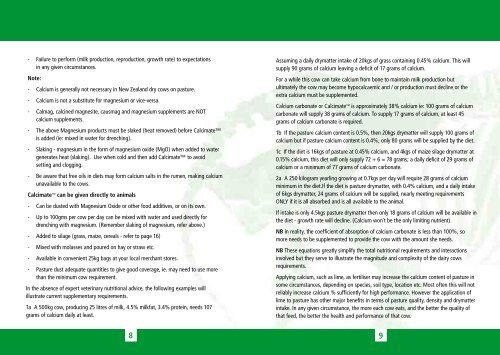CALCIUM & THE DAIRY COW - McDonald's Lime
CALCIUM & THE DAIRY COW - McDonald's Lime
CALCIUM & THE DAIRY COW - McDonald's Lime
You also want an ePaper? Increase the reach of your titles
YUMPU automatically turns print PDFs into web optimized ePapers that Google loves.
- Failure to perform (milk production, reproduction, growth rate) to expectations<br />
in any given circumstances.<br />
Note:<br />
- Calcium is generally not necessary in New Zealand dry cows on pasture.<br />
- Calcium is not a substitute for magnesium or vice-versa.<br />
- Calmag, calcined magnesite, causmag and magnesium supplements are NOT<br />
calcium supplements.<br />
- The above Magnesium products must be slaked (heat removed) before Calcimate<br />
is added (ie: mixed in water for drenching).<br />
- Slaking - magnesium in the form of magnesium oxide (MgO) when added to water<br />
generates heat (slaking). Use when cold and then add Calcimate to avoid<br />
setting and clogging.<br />
- Be aware that free oils in diets may form calcium salts in the rumen, making calcium<br />
unavailable to the cows.<br />
Calcimate can be given directly to animals<br />
- Can be dusted with Magnesium Oxide or other food additives, or on its own.<br />
- Up to 100gms per cow per day can be mixed with water and used directly for<br />
drenching with magnesium. (Remember slaking of magnesium, refer above.)<br />
- Added to silage (grass, maize, cereals - refer to page 16)<br />
- Mixed with molasses and poured on hay or straw etc.<br />
- Available in convenient 25kg bags at your local merchant stores.<br />
- Pasture dust adequate quantities to give good coverage, ie. may need to use more<br />
than the minimum cow requirement.<br />
In the absence of expert veterinary nutritional advice, the following examples will<br />
illustrate current supplementary requirements.<br />
1a A 500kg cow, producing 25 litres of milk, 4.5% milkfat, 3.4% protein, needs 107<br />
grams of calcium daily at least.<br />
8<br />
Assuming a daily drymatter intake of 20kgs of grass containing 0.45% calcium. This will<br />
supply 90 grams of calcium leaving a deficit of 17 grams of calcium.<br />
For a while this cow can take calcium from bone to maintain milk production but<br />
ultimately the cow may become hypocalcaemic and / or production must decline or the<br />
extra calcium must be supplemented.<br />
Calcium carbonate or Calcimate is approximately 38% calcium ie: 100 grams of calcium<br />
carbonate will supply 38 grams of calcium. To supply 17 grams of calcium, at least 45<br />
grams of calcium carbonate is required.<br />
1b If the pasture calcium content is 0.5%, then 20kgs drymatter will supply 100 grams of<br />
calcium but if pasture calcium content is 0.4%, only 80 grams will be supplied by the diet.<br />
1c If the diet is 16kgs of pasture at 0.45% calcium, and 4kgs of maize silage drymatter at<br />
0.15% calcium, this diet will only supply 72 + 6 = 78 grams; a daily deficit of 29 grams of<br />
calcium or a minimum of 77 grams of calcium carbonate.<br />
2a A 250 kilogram yearling growing at 0.7kgs per day will require 28 grams of calcium<br />
minimum in the diet.If the diet is pasture drymatter, with 0.4% calcium, and a daily intake<br />
of 6kgs drymatter, 24 grams of calcium will be supplied, nearly meeting requirements<br />
ONLY if it is all absorbed and is all available to the animal.<br />
If intake is only 4.5kgs pasture drymatter then only 18 grams of calcium will be available in<br />
the diet - growth rate will decline. (Calcium won't be the only limiting nutrient).<br />
NB In reality, the coefficient of absorption of calcium carbonate is less than 100%, so<br />
more needs to be supplemented to provide the cow with the amount she needs.<br />
NB These equations greatly simplify the total nutritional requirements and interactions<br />
involved but they serve to illustrate the magnitude and complexity of the dairy cows<br />
requirements.<br />
Applying calcium, such as lime, as fertiliser may increase the calcium content of pasture in<br />
some circumstances, depending on species, soil type, location etc. Most often this will not<br />
reliably increase calcium % sufficiently for high performance. However the application of<br />
lime to pasture has other major benefits in terms of pasture quality, density and drymatter<br />
intake. In any given circumstance, the more each cow eats, and the better the quality of<br />
that feed, the better the health and performance of that cow.<br />
9


